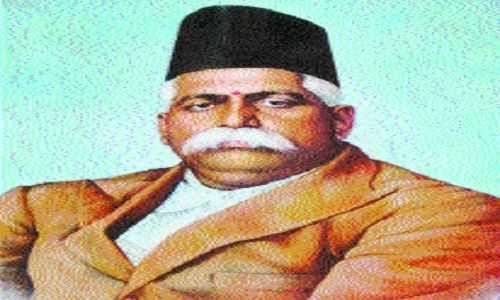100 yrs ago, when Dr Hedgewar walked out of Nagpur jail to a rousing welcome
| Date :12-Jul-2022 |

By Kartik Lokhande
“WE HAVE to place before the nation the highest and the noblest of goals, and any goal short of Complete Independence will not be of any use. Today’s audience knows very well the history of freedom struggle. To tell them anything about the method to achieve it (Complete Independence), will amount to their insult. Even if death were to stare us in the face, we should not bother. While running the struggle for freedom, our goals should of the highest order, and mind balanced one.”
The above words of Dr Keshav Balirampant Hedgewar, a Congressman who later rose to eminence as founder of Rashtriya Swayamsevak Sangh (RSS), were drenching the souls of scores of people who had gathered inside and outside the Vyankatesh Theatre on July 12, 1922. Heavy rains were lashing Nagpur that day. Yet,
people who had gathered were undeterred. They had assembled to accord a warm reception to Dr Hedgewar, who was released from his first imprisonment that day. He had served a prison sentence of almost one year for participating in Indian freedom struggle. Back then, he was in Congress party.
Among other resources, there are three books that mention in some detail how Dr Hedgewar got a rousing welcome upon his release from the jail in Ajni area of Nagpur. These books are: ‘Dr Hedgewar’ by Narayan Hari Palkar; ‘Dr Hedgewar: The Epoch Maker’ by H V Sheshadri; and ‘Builder of Modern India -- Dr Keshav Baliram Hedgewar’ authored by Rakesh Sinha (currently a Member of Rajya Sabha) and published by Publications Division of Ministry of Information and Broadcasting, Government of India. These books cite several publications of the time, with the most prominent being Nagpur-based popular news publication ‘Maharashtra’, to describe how Dr Hedgewar was received by the people on July 12, 1922 upon his release. While the book by Palkar and Sheshadri state that Dr Hedgewar was released from prison on July 12, 1922, Sinha states in his book that Dr Hedgewar was released a day earlier.
In his school days, Dr Hedgewar was expelled from a school in Nagpur for raising ‘Vande Mataram’ slogan and refusing to apologise for it. According to Sinha’s book, in 1909, Dr Hedgewar was accused of instigating people against the British regime and hurling a bomb on a police outpost. In 1921, Dr Hedgewar was among seven people from Central Provinces who were charged with ‘sedition’. Because of his participation in revolutionary activities, the British government had -- seven years earlier -- placed him in the list of ‘probable dangerous political criminals’.
“He was charged under the Criminal Procedure Code and a case was slapped on him in May 1921. Hedgewar’s increasingly anti-regime activities made the colonial government resolute to punish him. This was the reason his two speeches delivered (on October 24, 1920) in meetings at Katol and Bharatawada were used as a pretext for the charges against him. Hedgewar had chaired those meetings. He was accused of inflammatory speeches, inciting hatred and of promoting subversion of the government,” states Sinha in his book.
During the course of trial, Dr Hedgewar had condemned colonialism as an inhuman, immoral, unlawful and cruel form of rule and supported all forms of opposition to the British legal system, police, administration and imperial rule. His fearless defence of anti-colonial stance infuriated the trial magistrate who declared Dr Hedgewar’s defence arguments as ‘even more seditious’ than his earlier speeches.
Even during imprisonment, Dr Hedgewar stuck to nationalist goals. He decided to observe the ‘Jallianwala Bagh Day’ on April 13, 1922 inside the jail.
According to references in the books by Palkar, Sheshadri, and Sinha, though it was raining heavily when Dr Hedgewar (popularly referred to as Doctor-ji) was released from the prison, his friends including Dr B S Moonje, Dr L V Paranjpe, Dr N B Khare, Balwantrao Mandlekar, Appasaheb Haidar, Dr Panchkhede and Veer Harkare, and others were waiting for him outside. After receiving their greetings and garlands of flowers, Dr Hedgewar proceeded towards his home. On the way, he was greeted at several places.
A reception meeting was organised at Chitnis Park in Mahal on the evening of July 12, 1922. However, due to heavy rainfall, the venue of the meeting was changed to Vyankatesh Theatre. The Congress stalwarts of the time namely Pt Motilal Nehru, Vitthalbhai Patel, Hakim Ajmal Khan, Dr Ansari, C Rajagopalachari, Kasturiranga Iyengar had come to Nagpur to attend Congress Working Committee meeting. As per the above-mentioned records, Dr N B Khare presided over the meeting. The theatre was jam-packed with people, and many people were standing outside undeterred by rains. The senior Congress leaders felicitated Dr Hedgewar to which people responded with loud rounds of applause. Pt Motilal Nehru and Hakim Ajmal Khan addressing the gathering on this occasion.
Later on, responding to his felicitation, Dr K B Hedgewar made the above-mentioned statement regarding Complete Independence of India.
After that meeting in Nagpur, Dr Hedgewar was felicitated at various places across Vidarbha including Yavatmal, Wani, Arvi, Wadhona, Mohpa, Akola, Chandrapur (then, Chanda). Rallies were taken out to mark his felicitation. His ‘aarti’ was performed and many
presented to him Khadi clothes. The meeting at Yavatmal was presided over by ‘Loknayak’ Bapuji Aney, states the book written by N H Palkar.
Dr Hedgewar was imprisoned on other occasions too. He was imprisoned for the second time for leading ‘Jungle Satyagraha’ during ‘Civil Disobedience Movement’ in 1930. He was imprisoned for nine months for his role in Civil Disobedience Movement.







